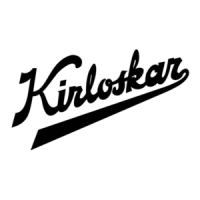What does warm suction side of H.P. safety mean for KIRLOSKAR Air Compressor?
- JJacqueline RomeroSep 13, 2025
A warm suction side of the H.P. safety indicates a leaking safety valve. Repair or replace the valve.

What does warm suction side of H.P. safety mean for KIRLOSKAR Air Compressor?
A warm suction side of the H.P. safety indicates a leaking safety valve. Repair or replace the valve.
| Brand | KIRLOSKAR |
|---|---|
| Model | KC4 |
| Category | Air Compressor |
| Language | English |
Essential guidelines for safe operation, maintenance, and handling of the compressor.
Proper planning and precautions for lifting and handling the compressor to avoid damage.
Guideline for selecting appropriate lifting slings and shackles for material handling.
Checks and priming procedures before starting the compressor and during initial runs.
Guidelines for compressor operation and cylinder loading for single and two-stage units.
Schedule for oil, filter, and strainer checks after initial run and subsequent periods.
Details on the safety valve, its function, and the importance of its proper operation.
Detailed steps for operating the compressor, including no-load starting and bringing cylinders on load.
Explanation of liquid stroke, its potential for damage, and protective devices.
Precautions related to ammonia handling, storage, and potential health hazards.
Safety precautions for Freon, including its characteristics and leak detection.
Method for testing the plant's soundness using gas pressure, typically air or nitrogen.
Detailed steps for evacuating Freon systems using a compressor and vacuum pump.
Procedure for evacuating ammonia plants using only the compressor.
Steps for charging the system with refrigerant after leak testing and evacuation.
Step-by-step guide for starting the compressor, including initial oil pickup and operation.
Advisories on operating single-stage compressors at minimum capacity steps and discharge temperature limits.
Careful procedure for starting and loading two-stage compressors to avoid temperature/pressure issues.
Sequence of operations for starting and increasing capacity, considering evaporation and condensing temperatures.
Guidelines on using capacity control steps for pull-down and minimum load requirements.
Methodology for determining minimum capacity steps for reduced heat loads and avoiding operational issues.
Guidelines for periodic inspection and maintenance of valves, piston rings, and bearings.
Importance of lubrication records, oil renewal, topping up procedures, and oil pressure checks.
Function and importance of pressure switches for safety and operational control.
Protection provided by the oil pressure differential pressostat against low oil pressure.
Troubleshooting high/low suction and discharge pressure issues.
Troubleshooting high/low oil pressure and high oil consumption.
Troubleshooting liquid stroke, pressure difference, loading/unloading malfunctions.
Troubleshooting warm HP safety valve side and shaft seal leakage.
Identification of common sources of system dirt that cause compressor failures.
Methods to avoid dirt entry, including flushing systems and using cloth bags in strainers.
Steps to take before first start and during initial runs to prevent compressor damage.
Guidelines for restarting the compressor, using new oil, and checking pressure settings.
